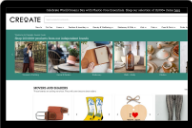
‘Cutting costs’ is too often confused with cutting corners or taking short-cuts for measly savings. In reality, and if done right, cost reduction in business can actually benefit your business by allowing you to spend more on what your consumers really value.
In this post you’ll find a comprehensive list of the most successful methods to reduce costs for your retail business and while it’s worth considering each one, we recommend selecting just a few to get you started. Read through the options below and discover which methods feel most relevant to you and your business.
7 Ways to cut costs in retail business:
- Conduct an initial audit
- Consider leasing out your space
- Rethink your packaging
- Slice shipping costs
- Make the move to online retail
- Take advantage of outsourcing
- Negotiate with your vendors
1. Conduct an initial audit
Audits don’t have the best reputation. They’re never very exciting, but they do tend to offer the best chance of finding instant savings. It often requires you to be harsh, so consider asking valued employees to lend a critical eye. The goal is to suss out any unnecessary expenditures that stand in the way of you and the progress of your venture.
Research has shown that similar retail stores can have up to 40% difference in their energy expenditures; an expense that makes up around 4-9% of the cost of running your business.
Plan an updated inventory inspection. At this point it’s worth checking if your repeat orders are just as popular as they were. You may be unknowingly hoarding products that just don’t sell like they used to. This simple check-up could save both precious inventory space, as well as cut your monthly expenses, making way for new opportunities.
If you operate a brick and mortar retail business, think electricity, gas, and the number of people on the floor. If your heating is set to a timer, are there always people in your store at this time? When was the last time you revised your rota? It could be time to rethink how many people are needed for an effective close down — or indeed if your actual opening hours should be adjusted:
Ask the Experts: Selin, Create & Wild
‘We are a florist based in a residential area, Sheen, in Richmond, UK. We noticed that our customers’ visiting hours changed significantly over the last 18 months. As many are working from home, customers have been visiting more often during the day rather than in the evenings. This has actually helped us decide that our pre-lockdown opening hours no longer serve us and our clients well.'

'We previously had a huge commuter rush at the end of the day, and this sadly no longer really exists. We have begun to close earlier rather than staying until 8pm, our previous closing time. Takings have decreased overall, but in some ways, as a small independent business with just a couple members of staff, I have been able to create a more sustainable way of working.’
2. Consider leasing out your space
You’ve cleared out your inventory, made changes to your repeat orders, and are now left with empty space and are wondering: what’s next? Before this area becomes a dumping ground for staff coats and random returns, it’s time to consider whether this area could be offered as rentable space. The same goes for other areas of your shop floor; try to re-imagine this as a potential source of income.
With the rising popularity of short-term retail leases, you could attract pop-ups and other small businesses who’d like to feature their products in your store. Or if you’re in the right area, a coffee shop or even storage rental could be a better fit. Research shows that pop-up retail contributes approximately £2.3 billion to the UK economy, and is growing exponentially.
Ultimately, if you don’t need it, it makes sense to share your rental space to make the most of this shift in retail behaviour, and invest these savings in the growth of your business. mlkwood Store is one independent business that chose to take advantage of this shift by collaborating with a local coffee shop.
Ask the Experts: Lauren, mlkwood Store

‘During the pandemic we joined forces with Jordan of Three Ridings Coffee to combine both businesses under one roof…I know historically they say don’t spread yourself too thin, but with COVID we found doing so has helped us ride things out a little easier. Not just from a sales perspective but also a mental one. It’s much easier to work on growing a specific part of the business, whilst one (wholesale coffee during the pandemic, for instance) slows.’
3. Rethink your packaging
The cost of packaging orders is often overlooked. It’s an expense that at first glance seems necessary before really delving in. While it’s important that your packaging is safe so that your products can reach your customers in the same condition as when they left your store, you can still assess the trimmings. Things like branded tissue, magazines, leaflets and fillers are all common extras found in packaging that tend to quickly add up. It’s worth deciding which items add value, and begin cutting out the excess.
4. Slice shipping costs
After ruling out all the unnecessary expenses, you can begin to think about where you can negotiate to create additional savings for your business.
When you think about shipping, cost reduction can look like a few different things. It could be using more exact shipping boxes to reduce the dimensional weight of your items. Nowadays, it’s possible to get shipping boxes that can be resized to fit the items you’re sending. This both saves you from having to buy in multiple sizes of stock boxes, as well as reducing your overall shipping costs.
Another cost effective switch to consider making, is based on whether the items you’re sending are delicate or not. If the items are not at risk of being damaged through delivery, then shipping mailers could be a simple way to minimise costs for your retail business. Mailers are lightweight and generally occupy much less space on delivery trucks than traditional cardboard boxes. So if your items are low-risk, this could be an effective switch for you.
5. Make the move to online retail
The past decade has shown us a trend of more and more consumers sourcing products online, and COVID only accelerated this. With 20.1% of retail sales predicted to take place online according to Forbes – if you haven’t already considered opening an online store, it’s time to view it as a modern means of cost reduction.
It could be the case that your consumers prefer online shopping at certain times of the year, and at other times rely on the full customer experience of a brick and mortar store. Operating as a part-time pop-up is something worth investigating because it ensures your customers’ needs are met while ruling out expensive bills during periods of substantially lower foot traffic.
6. Take advantage of outsourcing
Let’s say your online store is up and running but you think it’s time to optimise this service, and iron out a few of the kinks. It can be hard to be critical of the service you offer, so gaining some customer feedback is a worthwhile option before making any drastic changes. This will help determine whether more attention is needed for your marketing, social media, or any other aspect of running your business.
Outsourcing could actually be an effective method for minimising costs due to time saved. Ultimately, if someone else would be more efficient in these roles, you can take advantage of delegation so that your personal efforts are directed where they’re needed, all the while increasing your number of happy customers.
7. Negotiate with your vendors
After auditing just about every part of running your retail business, it’s finally time to audit an often forgotten part of the jigsaw – your business relationships.
By reliably providing repeat sales for your vendors, there’s often room for negotiation to benefit your business finances. Depending on how long you’ve worked with your vendors, you could benefit from lower prices on the items you buy due to the reliability of repeat sales. Another more obvious option is bulk buying. If your store has seasonal bestsellers, predicting these early and buying in bulk accordingly can amount to substantial savings for your business.
It’s reported that retail businesses generally save a minimum of 25% when buying in bulk.
FAQs
What is the formula for cost minimisation?
In the cost minimisation formula, the ratio of the marginal product of labour to the wage rate is equal to the ratio of the marginal product of capital to the rental price of capital. If you're trying to calculate a price increase, the following formula might help: (New Price - Old Price) ÷ Old Price, then multiply that number by 100. To calculate price decrease: (Old Price - New Price) ÷ Old Price and multiply that number by 100.
What is Porter's low cost strategy?
According to academic Michael Porter, companies can gain a strategic advantage by adopting either a low-cost strategy or a differentiation strategy when planning out their financials. A low-cost strategy involves offering goods or services similar to those of their competitors but at a reduced cost.
Final thoughts: how to reduce costs in retail business
All these methods have been proven to successfully reduce costs for retail businesses, but not all will contribute to growing your business. It’s important to keep in mind that every business is different so when selecting from the options, pay attention to what really suits you and the needs of your customers.
A ceramics shop likely shouldn’t cut costs on packaging since the items are easily damaged, in the same way that a souvenir shop probably won’t migrate entirely online. At every point, take a step back and determine whether each change allows you to maintain the same value for your customer while saving costs, too.
Not registered with CREOATE yet? Sign up now and shop wholesale with us today.
Related posts:








